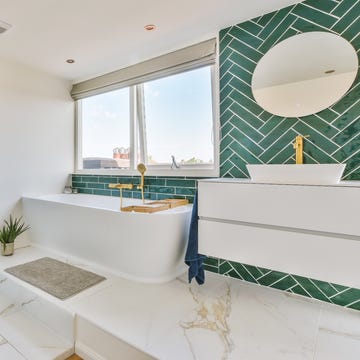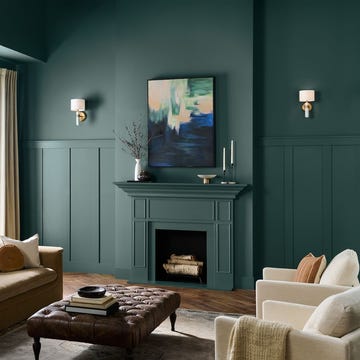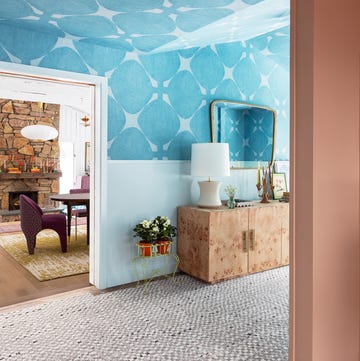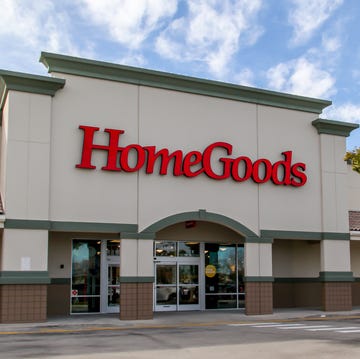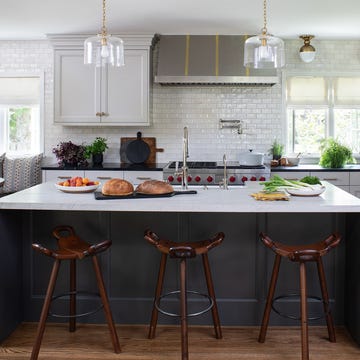There are aspects of historic kitchens that not many people would want to return to. Tuscan themes and orange-hued cabinetry are just two examples from the past, but there's another one that design experts say deserves a second look—sculleries. Yes, sculleries, or prep kitchens, are making a major comeback.
Common in 19th century aristocracy as an area for doing chores like washing dishes and laundering clothes, a scullery can be thought of as a zone where the more hard-earned tasks of running a home take place. A scullery was often adjacent to a main kitchen, keeping that area clear of the scrubbing, dunking and general water-logged quality of the room. “Essentially, they were a 'dirty' utility space subservient to a kitchen,” says architect Nicholas G. Potts. “It wasn’t a place where food was stored.”
Recently, the term has reemerged as a prep kitchen, a term Potts says is more flexible to how homeowners may use this space today—without any of the complicated class implications. “The archaic use of a scullery as a dishwashing-only room is not something that's relevant to us given that we now have dishwashers and far fewer specific pieces of tableware,” he says. “But a prep kitchen is a great solution for homeowners with a lot of available space who entertain frequently. Because a prep kitchen can be sealed off, it's also a nice fit for pickling, canning and so on.” Here’s why more and more homeowners are investing in prep kitchens.
Why Prep Kitchens Are Popular Now
Rachel Robinson, architect and founding partner of Dunham Robinson, says that the trend of finding extra square footage for this prep space makes sense given how many tasks modern kitchens oversee. “Today’s kitchens almost invariably do double duty,” she says. “They’re workhorses for daily cooking while often serving as the heart of the home: for entertaining, hanging out as a family, or decompressing and catching up after work. And that’s a lot to ask of one space. I would hypothesize that sculleries, or prep kitchens, have re-emerged because they take off some of that pressure.”
This secondary kitchen could be used to store items that only come out for a crowd, as well as specialty pieces that emerge from cabinets every so often. “It’s a modern twist on a traditional idea—separating private working spaces from public entertaining spaces—that just makes life easier. In that sense, a scullery is like the backstage of a home: it holds all the supporting cast so the main kitchen can be the star.”
Melissa Oholendt, founder and design principal at Oho Interiors, agrees that prep kitchens have staying power, even if it’s a room from the past. “It's highly functional and can serve a larger purpose in a home,” she says. “We don't see this trend dying in popularity but rather taking the shape of a modern family’s needs, and that is exciting!”
How to Know If a Scullery Is Right for You
Trends are not for everyone, particularly if they involve construction. But if you think a scullery should be a part of your home, here’s what you should consider:
- Planning is key. A prep kitchen won’t necessarily need as much space as, say, a dining area, but it does usually require precious square footage to make it worthwhile. More so, it has to be very functional—otherwise, you likely won’t use it. “Space planning is critical here,” Potts says. “It should be easily accessible (with direct garage or hallway access), have a sink, adequate counter space (with power), refrigeration and some closed or shelf storage if it's also used for bulk ingredients.”
- Cooking must be a passion. If your calendar is routinely booked with events at home where you’re the chef, this is likely the right move. “If our clients are big on hosting—especially for the holidays—or if the client really wants a simplified kitchen, we will encourage a scullery for function,” Oholendt says. “But if we have clients who order more takeout than cook, a scullery would drive construction costs up in a way that doesn't feel productive!”
- It can work for apartments, too. While a scullery harkens back to an era where a large estate’s staff worked behind the scenes, a modern take on this space can be introduced into a smaller home. “We recommend a scullery when clients love to entertain or have a treasured collection of glassware, serving pieces or appliances that can overwhelm a single kitchen, especially in a city apartment,” Robinson says. “It’s also ideal when the main kitchen is meant to feel open and minimal. Having a separate zone for storage and prep ensures that look is easy to maintain.”

Kelly Dawson is a writer, editor and marketing consultant. Her work has appeared in the New York Times, Architectural Digest, Travel + Leisure and other publications.




